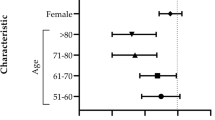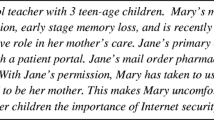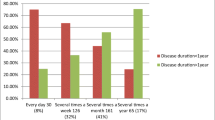Abstract
Family caregivers play an important role to care cancer patients since they exchange medical information with health care providers. However, relatively little is known about how family caregivers seek medical information using mobile apps and the Internet. We examined factors associated with medical information seeking by using mobile apps and the Internet among family caregivers and the general public using data from the 2014 Health Information National Trends Survey 4 Cycle 1. The study sample consisted of 2425 family caregivers and 1252 non-family caregivers (the general public). Guided by Comprehensive Model of Information Seeking (CMIS), we examined related factors’ impact on two outcome variables for medical information seeking: mobile apps use and Internet use with multivariate logistic regression analyses. We found that online medical information seeking is different between family caregivers and the general public. Overall, the use of the Internet for medical information seeking is more common among family caregivers, while the use of mobile apps is less common among family caregivers compared with the general public. Married family caregivers were less likely to use mobile apps, while family caregivers who would trust cancer information were more likely to use the Internet for medical information seeking as compared to the general public. Medical information seeking behavior among family caregivers can be an important predictor of both their health and the health of their cancer patients. Future research should explore the low usage of mobile health applications among family caregiver population.
Similar content being viewed by others
References
Kim, H., and Xie, B., Health literacy and internet-and mobile app-based health services: a systematic review of the literature. Proceedings of the Association for Information Science and Technology. 52(1):1–4, 2015.
Cline, R.J., and Haynes, K.M., Consumer health information seeking on the internet: the state of the art. Health Education Research. 16(6):671–692, 2001.
Hawkes, C.P., Walsh, B.H., Ryan, C.A., and Dempsey, E.M., Smartphone technology enhances newborn intubation knowledge and performance amongst pediatric trainees. Resuscitation. 84(2):223–226, 2012.
Fox, S., and Duggan, M., Mobile health 2012. Pew Internet & American Life Project, Washington, DC, 2012.
Wallace, S., Clark, M., and White, J., ‘It’s on my iPhone’: attitudes to the use of mobile computing devices in medical education, a mixed-methods study. BMJ Open. 2(4):e001099, 2012.
Boulos, M.N., Wheeler, S., Tavares, C., and Jones, R., How smartphones are changing the face of mobile and participatory healthcare: an overview, with example from eCAALYX. Biomedical Engineering Online. 10(24), 2011. doi:10.1186/1475-925X-10-24.
Pandey, A., Hasan, S., Dubey, D., and Sarangi, S., Smartphone apps as a source of cancer information: changing trends in health information-seeking behavior. Journal of Cancer Education. 28(1):138–142, 2013.
Cotton, S.R., and Gupta, S.S., Characteristics of online and offline health information seekers and factors that discriminate between them. Social Science & Medicine. 59(9):1795–1806, 2004.
Kelly, B., Hornik, R., Romantan, A., Schwartz, J.S., et al., Cancer information scanning and seeking in the general population. Journal of Health Communication. 15(7):734–753, 2010.
Oh, Y.S., Predictors of self and surrogate online health information seeking in family caregivers to cancer survivors. Social Work in Health Care. 54(10):939–953, 2015.
Lim, S., Xue, L., Yen, C.C., Chang, L., et al., A study on Singaporean women’s acceptance of using mobile phones to seek health information. International Journal of Medical Informatics. 80(12):e189–e202, 2011. doi:10.1016/j.ijmedinf.2011.08.007.
Knorr, K., Aspinall, D., and Wolters, M. (2015). On the privacy, security and safety of blood pressure and diabetes apps. In: ICT Systems Security and Privacy Protection (pp. 571–584). Springer International Publishing.
Ranchordas, S., and Kaplan, B. (2016). MHealth for Alzheimer’s disease: Regulation, Consent, and Privacy Concerns. In: Beyond IP: The Future of Privacy (Fordham University Press, 2017), Forthcoming.
Arrington, M.I., “She’s right behind me all the way”: an analysis of prostate cancer narratives and changes in family relationships. Journal of Family Communication. 5(2):141–162, 2005. doi:10.1207/s15327698jfc0502_5.
Bevan, J.L., and Pecchioni, L.L., Understanding the impact of family caregiver cancer literacy on patient health outcomes. Patient Education and Counseling. 71(3):356–364, 2008.
Matthews, A.K., Sellergren, S.A., Manfredi, C., and Williams, M., Factors influencing medical information seeking among African American cancer patients. Journal of Health Communication. 7(3):205–219, 2002.
Johnson, J.D., and Meischke, H., A comprehensive model of cancer-related information seeking applied to magazines. Human Communication Research. 19(3):343–367, 1993.
Pennbridge, J., Moya, R., and Rodrigues, L., Questionnaire survey of California consumers’ use and rating of sources of health care information including the internet. Western Journal of Medicine. 171(5–6):302, 1999.
Hesse, B.W., Nelson, D.E., Kreps, G.L., Croyle, R.T., et al., Trust and sources of health information: the impact of the internet and its implications for health care providers: findings from the first health information National Trends Survey. Archives of Internal Medicine. 165(22):2618–2624, 2005.
Johnson, J. D., Cancer-related information seeking: Hampton Press, 1997.
Holden, R.J., and Karsh, B.T., The technology acceptance model: its past and its future in health care. Journal of Biomedical Informatics. 43(1):159–172, 2010.
Zhao, X., and Cai, X., The role of risk, efficacy, and anxiety in smokers’ cancer information seeking. Health Communication. 24(3):259–269, 2009.
National Cancer Institute (2016). What is HINTS. Retrieved May 17, 2016 from http://url.hints.cancer.gov/
Nguyen, G.T., and Bellamy, S.L., Cancer information seeking preferences and experiences: disparities between Asian Americans and whites in the health information National Trends Survey (HINTS). Journal of Health Communication. 11(S1):173–180, 2006.
Bhuyan, S.S., Lu, N., Chandak, A., Kim, H., Wyant, D., Bhatt, J., Kedia, S., and Chang, C.F., Use of mobile health applications for health-seeking behavior among US adults. Journal of Medical Systems. 40(6):1–8, 2016.
National Cancer Institute (2016). Frequently asked questions about HINTS. Retrieved May 17, 2016 from http://url.hints.cancer.gov/faq.aspx.
Zulman, D.M., Piette, J.D., Jenchura, E.C., Asch, S.M., et al., Facilitating out-of-home caregiving through health information technology: survey of informal caregivers’ current practices, interests, and perceived barriers. Journal of Medical Internet Research. 15(7):e123, 2013.
National Alliance for Caregiving and United Healthcare. (2011). e-Connected family caregiver: Bringing caregiving into the twenty-first century. Retrieved June 25, 2016 from http://url.caregiving.org/data/FINAL_eConnected_Family_Caregiver_Study_Jan%202011.pdf
Chou, W.Y.S., Liu, B., Post, S., and Hesse, B., Health-related internet use among cancer survivors: data from the health information National Trends Survey, 2003–2008. Journal of Cancer Survivorship. 5(3):263–270, 2011.
Oh, Y.S., and Cho, Y., Examining the relationships between resources and online health information seeking among patients with chronic diseases and healthy people. Social Work in Health Care. 54(2):83–100, 2015.
Armstrong, K., Ravenell, K.L., McMurphy, S., and Putt, M., Racial/ethnic differences in physician distrust in the United States. American Journal of Public Health. 97(7):1283–1289, 2007.
Basch, E.M., Thaler, H.T., Shi, W., Yakren, S., and Schrag, D., Use of information resources by patients with cancer and their companions. Cancer. 100(11):2476–2483, 2004.
Dutta-Bergman, M.J., Primary sources of health information: comparisons in the domain of health attitudes, health cognitions, and health behaviors. Health Communication. 16(3):273–288, 2004.
Pálsdóttir, Á., Information behavior, health self-efficacy beliefs and health behavior in Icelanders’ everyday life. Information Research. 13(1):4, 2008.
Rimal, R.N., Perceived risk and self-efficacy as motivators: understanding individuals’ long-term use of health information. Journal of Communication. 51(4):633–654, 2001.
Adhikari, R., Richards, D., and Scott, K., Security and privacy issues related to the use of mobile health apps. In: Australasian Conference on Information Systems (ACIS), 2014.
Gregory-Head, B., Patients and the internet: guidance for evidence-based choices. The Journal of the American College of Dentists. 66(2):46–50, 1998.
Silberg, W.M., Lundberg, G.D., and Musacchio, R.A., Assessing, controlling, and assuring the quality of medical information on the internet: Caveant lector et viewor—let the reader and viewer beware. JAMA. 277(15):1244–1245, 1997.
Author information
Authors and Affiliations
Corresponding author
Additional information
This article is part of the Topical Collection on Mobile & Wireless Health
The original version of this article was revised: Soumitra Sudip Bhuyan should be removed since the name of the author was listed twice as Soumitra S. Bhuyan. Additionally, the word “Management” in the author's affiliation was misspelled.
An erratum to this article is available at http://dx.doi.org/10.1007/s10916-017-0707-6.
Rights and permissions
About this article
Cite this article
Kim, H., Paige Powell, M. & Bhuyan, S.S. Seeking Medical Information Using Mobile Apps and the Internet: Are Family Caregivers Different from the General Public?. J Med Syst 41, 38 (2017). https://doi.org/10.1007/s10916-017-0684-9
Received:
Accepted:
Published:
DOI: https://doi.org/10.1007/s10916-017-0684-9




